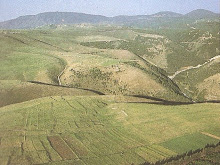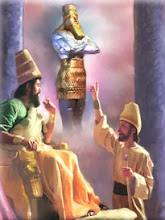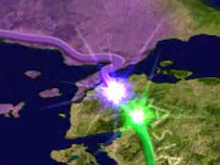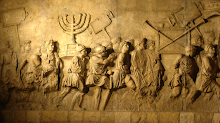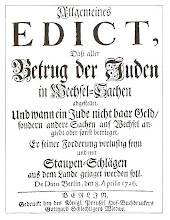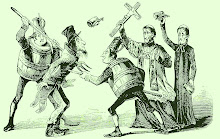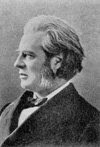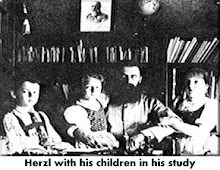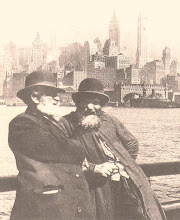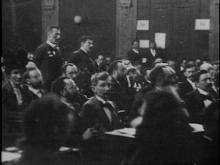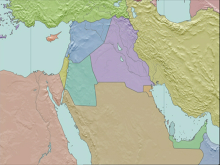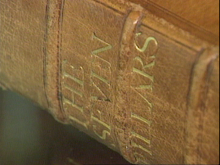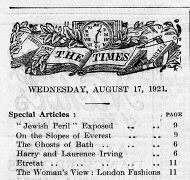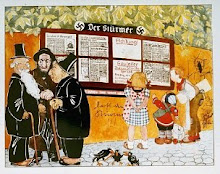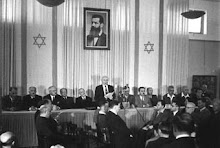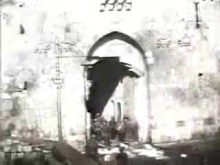The world’s best-known teller of Parables is Jesus Christ, and several of these ‘symbolic stories with hidden meanings’ that He linked together could have profound implications for The Signpost Years.
The three parables of interest all involve the symbol of a fig tree, and the last two, recounted only hours apart and under unusual circumstances, were a major part of Jesus’ final week of ministry before the events of the cross.
Parables can be spoken, acted-out like a drama, or even involve the miraculous as means of illustrating and impressing an important truth. The technique is used to facilitate memory and learning, further contemplation and deepen insight. Importantly, the symbols in a parable stand for, or substitute for, a key ‘something else’ that is actually tangible and substantial in reality. Jesus’ parables most frequently keyed of themes associated with the Kingdom of Heaven.(1)
THE FIRST FIG TREE PARABLE: is a short story Jesus told in the autumn of AD 30, just six months before His crucifixion.
‘A man owns a garden where a fig tree is planted but which, after three years, has produced no fruit. He goes to his gardener and recommends the tree be cut down, it is using up the ground. But the gardener suggests a further short period of special attention to the tree, to compost and support it, and if within a year fruit is still un-forthcoming, it should be removed.’
Jesus’ parables are a bit like Daniel’s mysterious numbers and symbols from which Clarke and Guinness derived the Signpost Years; both Biblical accountants use a form of algebra, substituting symbols for real things that are their equivalent. For example, in this first parable, Jesus uses the fig tree specifically as a symbol representing the people of Israel at that time. The same symbol of the nation was used in their own old testament Bible, so they would understand His parable refers to them.(2)
And Jesus had actually, by then, ministered to the people for three years, but they have produced no spiritual fruit and were in danger of being up-rooted as a consequence. Now, only a little more time and special attention will be given – by Jesus Himself as the gardener in the parable.
In the following springtime, six months later, and on the Monday morning of His last week of ministry to Israel before the crucifixion on Friday, Jesus delivers the second, linked, fig tree parable. The verbal story-telling method is replaced by an even more reinforcing technique.
THE SECOND FIG TREE PARABLE: Enacting the story for special impact.
‘Early Monday, approaching Jerusalem and its Temple to teach there, Jesus spots a fig tree along the road and feeling hungry approaches it to see if there is any fruit on it. But the tree is barren with leaves only. He rebukes the tree severely, stating that it should never be the bearer of fruit again. Some of His followers appear to notice a subtle but immediate change at the tree base, though it is really on the next day, Tuesday morning, following the same walk to Jerusalem, that they see the tree has completely withered away, upwards from its roots.’ (3)
The enactment of this parable is remarkable in several ways. It involves a ‘deconstructive miracle’, in a gesture and effect unlike anything His followers had ever seen before. Even under serious threat and personal attack, Jesus never struck back, responded with a negative outburst, or used power in a harmful negative way, yet alone in a context that was apparently unjustified; He knew too well it was not even the time of year for figs, and the Bible suggests that also.(4) Had He lost His mind?
The two events, Monday and Tuesday, with His uncharacteristic behaviour, must have burned itself into the memory of His disciples like a firebrand. And many would also recall His account in the first fig tree parable, just six months earlier, foretelling Israel’s precarious and impending fate should it not fruit spiritually in the near future.(1) The Jewish religious leaders must have understood the fig tree parable stood for themselves since we are told they grasped the same meaning from a closely similar parable Jesus gave at about the same time: It concerned an unproductive vineyard, its unfaithful and murderous tenants, and their eventual punishment.(5)
THE THIRD FIG TREE PARABLE: End time prophecy and a prophetic command.
But on Tuesday evening, sat on a hill above Jerusalem with a few of His followers, Jesus has one more fig tree parable to tell in the series (following a detailed end time prophecy) and He delivers it with maximum effect, that is while memories of the withered fig tree are still very much in their minds from earlier that same day. Notice how He includes both Jewish and Gentile components throughout:
He prophesies that the Jerusalem Temple will be destroyed by a nation who will build a barrier around the city and besiege its citizens. Its army will decimate the Jews, putting many to the sword, taking the rest captive as slaves to serve among other foreign nations. (This occurred in AD 70). There His believing followers will be dragged before the Kings and rulers of those gentiles. Meantime, bereft of the Jews who will be thus scattered worldwide, other nation states will appropriate and rule Jerusalem and the holy Land, in succession over many years. But critically, at a time when the world’s nations will be in distress and perplexity, and with kingdom fighting kingdom and wars continually rumoured, the gentile nations holding Jerusalem will suddenly relinquish their domineering control, and Jerusalem’s centuries-long ‘trampling underfoot’, prophesied originally by Daniel about 500 BC,(6) will come to an end.
Jesus then encapsulates this prophecy with a further prophetic summary and important hint, as Luke notes:
“And He spoke a parable to them: ‘Watch the fig tree and all the trees. Now when they sprout leaves, seeing it you know the summer is near. So also when you see these things happening, you know that the kingdom of God is near.’ ” (Luke 21:29-31).
[- Jay P., Green (editor and translator): The Interlinear Bible. Hebrew-Greek-English. Hendrickson Publishers. Mass. USA. 1985]
But there are several unusual features about the parable. Firstly, we know that all the symbols stand for something else because it’s a parable. Luke says it is.(7) Hence, what do the separate components ‘fig tree’ and ‘other trees’ stand for?(8) Why single out a fig tree (singular) among the other trees (plural)? And, this word ‘watch’ is quite significant here in the New Testament Greek because it is as a command to do so.(9) Why use this important, demanding and expectant word, if He’s just making a simple ‘comparison’ between budding trees and end time signs?
Most importantly, His follower’s heads are still reeling with Jesus’ uncharacteristic behaviour (10) and its startling consequences upon a fig tree they’d encountered twice within a day, and still only 12 hours ago. And now, He commands them to ‘Watch the fig tree’! Many today are convinced the fig tree is a symbol for national Israel.(11) Some of the reasons may be summarised thus:
a) The fig tree is used as a symbol elsewhere in the bible for Israel.
b) The Gardener and fig tree parable is clearly about Israel in relation to Jesus’ ministry.
c) Jesus’ ministry was about to end that (Passion) week and Israel will reject their messianic King; their spiritual state and its consequences are clearly meant to match that of the now withered fig tree.
d) Jesus’ ‘odd behaviour’ is a parable showing that Israel is about to be cast aside because of its lack of spiritual fruit – exemplified by the withered fig tree, and the fig tree parable warning of this given six months previously.
e) It is unnecessary, and bad methodology, to embellish a parable with superfluous data that might be misconstrued and falsify the semantic intent in the story. Each symbol is intended to have meaning. Jesus need only have said, ‘watch the trees budding’ to make a comparison point, but He specifies a fig tree as a separate component to the other trees, for an integral reason.
f) Jesus matches the parable of the ‘fig tree’ and ‘other trees’ alongside the prophetic timeline of dispersion and Diaspora of the Jews, and then the end times. The prophetic signs He gives are all about Israel and Jerusalem, and the impact of the successive gentile nations upon these throughout.
g) What else could a ‘fig tree and other trees’ symbolise, as real objects, in this parable?
SIGNPOST SIGNIFICANCE
Given that the fig tree is prophetic of Israel’s re-budding(12) in the end time prophecy of Luke 21, as many commentators already hold, the significance for the Signpost Years cannot be overstated: there is only one point in history, since Jesus uttered these words 2,000 years ago, that emphatically and unequivocally satisfies the criteria of national Israel showing signs of its re-budding.
That one epoch was identified clearly by Max Nordau as the period 1901 – 1903 AD precisely. Every effort prior to the achievements then had been surplus and getting the persecuted Jews in the Diaspora no-where, he insists. The turning point, he notes, was the fifth and sixth Congress meetings that saw the Aims and Methods of global Zionism, and the constitutional, economic and commercial machinery to actualise these, collate into existence and momentum for the first time.(13)
If this is the case, then Jesus with Daniel and Clarke are pointing directly, and temporally, to the same monumental turnaround for national Israel as dose Nordau.
But this is not all since Jesus’ prophecy also states that gentile nations, who will ransack Jerusalem and disperse the Jews, will do so only “until” the conclusion of the end time prophecy. The conditional article strongly implys, if not insists, that the Jews will then be back in Sovereign control of their former capital city because, if gentile nations are no longer its governing nationals, who else could be?
Furthermore, the entire prophetic timeline deals with the Gentiles, Jerusalem and Israel’s fate starting in AD 70 and up to the end times. The ending of the Gentile times(14) and “trampling down” in Daniel and Jesus’ words, must have some concluding contingency for Israel, as did its commencement.
Again, if this is the case, then Jesus, with Daniel and Clarke, is pointing to the only time in 2,000 years where this condition of reinstated Jewish ownership of all Jerusalem could have been met, the Signpost Year AD 1967.
For both Signpost Years indicated here in Luke 21, there is now no possibility of some future fulfilment of Jesus’ prophecy because, by nature, a prophetic sign must possess the attribute of being ‘one-off’ or ‘unique’. Otherwise, which instance do we select if there are several, or multiple cases of these, in order to identify significance?
In what way could Israel be said, in the future, to be showing the first signs of re-budding again after long centuries of stasis and Diaspora, or re-gaining Jerusalem as its Capital city for a first time in millennia, when it has blatantly just done so already, at the historically obvious Signpost junctures we have noted?
Each Signpost trajectory has one target only, and each of those located destinations in time were uniquely and hugely significant for Israel and the nations. They cannot be repeated or superseded and fully appear to have satisfied the criteria in Jesus’ prophecy, with Daniel and Clarke, and with recent history.
The Signpost Years alone identify the achievements of the zionist congresses and what they initiated at the turn of the last century, as fulfilling the intention in Jesus’ ‘Watch the fig tree and the other trees’ prophetic command, and the budding of the nation state of Israel - along with Clarke’s derivation of the time of its commencement from Daniel.
And only Clarke’s prospective Signpost Years matches Jesus’ prophetic statement that clearly indicates Israel’s recovery of the city of Jerusalem, ending millennia of gentile tenure there, with Daniel’s target of AD 1967, as a unique and un-missable end time signal to the world, still sounding loud, clear and urgently today.
References:
(1) The Fig Tree and Gardener: Luke 13:6-9
(2) The fig tree is one of the horticultural symbols used of Israel in the Old Testament well before Jesus’ usage, along with the olive tree and grape vine. Trees are also used there as symbols of other nations (- see Jer 11:16, 17 Hos. 9:10, Joel 1:7, Mic 7:1-7 for example).
(3) The Rebuking of the fig tree: Matt 21:19, Mark 11:13
(4) It was not the time of year for figs: Mark 11:13
(5) Vineyard workers and fruit (a parallel parable) – notably the text notes that the Jewish priesthood knew the parable was about them: Mark 12:1-12.
(6) Compare Daniel 8:9 and Luke 21:24, for example.
(7) Luke 21:29 ‘Then He spoke a parable to them…’
(8) Parable (Gk. parabolayn Luke 21:29): A mode of communicating meanings, especially spiritual and in Jesus’ case mostly contingent on teachings associated with the Kingdom of heaven. Everyday items such as fish, coins, sheep, trees, moon and stars, lamps, bread, wine, and so on, are matched symbolically alongside realities of the Kingdom, its requirements, realisation and attainment.
The Budding Fig Tree is ‘a parable’ Luke 21:29 tells us, and must therefore follow the rules of understanding this form of communication, precisely in the fashion we already do when interpreting all the other parables of Jesus: i.e., the symbolic components stand-in for something else that is tangibly associated with the unravelling of Kingdom concerns. Walter Martin, in Kingdom of the Cults (illustrating the existence of eternal judgement in the parable of the Rich Man and Lazarus), points out that Jesus never once used a symbol in any parable that did not have an absolute and real Kingdom analogue.
What else, then, critically in view of the Old Testament parable of Israel as a ‘fig-tree’, the impending fate of Israel in the ‘un-fruiting fig-tree’ parable, and the two parables incorporating the major fig-tree encounters of the previous 34 hours delineating Israel’s unfruitful state, could the parable of the ‘budding fig-tree’ otherwise symbolise?
(9) Having learned the parable from the fig-tree’s behaviour (compare Mark and Matthew’s details), Jesus also includes a directive to ‘watch the fig-tree’: Some translations have expressions matching, ‘Look at the fig tree…’ as if He is merely inviting comparison to a gradual appreciation of developing end time events.
But it has been pointed out that this is not strong enough from the Greek. The linguistic mood is in the Imperative (plural) sense for ‘beholding’ and it is here more of a direct command to all, and one to be maintained, ongoing indefinitely from the context. Jesus is telling us to learn what this parable teaches and keep watching the Fig Tree (national Israel) for its budding as signatory to His end time eschatology.
The internet StudyLight.org New Testament Greek Lexicon (New American Standard Bible) notes the Greek word Idete (Strong’s number 5628) in ‘watch the fig tree’: “The Imperative mood corresponds to the English Imperative, and expresses a command to the hearer to perform a certain action by the order and authority of the one commanding. Thus, Jesus’ phrase, ‘Repent ye, and believe the gospel’ (Mark 1:15) is not an “invitation”, but an absolute command requiring full obedience on the part of all hearers.”
Why would Jesus ‘absolutely command us by order and authority of Himself to obediently compare’ the budding behaviour of trees, simply as a means of comparison to end time signs? Clearly, something more is being commanded.
(see Mark 13:28-37 on the fig tree and the necessity of ‘watchfulness’).
(10) “The first figs ripen in late May or early June. The tree should have had fruit, unripe indeed, but existing…the leaves were a sign that there should have been fruit, unseen from a distance, underneath the leaves. The condemnation of this fig-tree lay in the absence of any sign of fruit.”
- Vines’s Expository Dictionary of New Testament Words. Revised version 1881-1885, under subject ‘Fig Tree’.
(11) Not all commentators see the fig tree as a symbol of Israel, but this is often because they have prior doctrinal predilections, seeing themselves as ‘spiritual Israel’ or suggesting that Israel has no further a part as participants in the unfolding divine plan. They do not easily accommodate what is, to some, a perfectly scriptural and obvious inference.
(12) A common objection that is made asks, ‘if the fig-tree is Israel, what are the other budding trees He tells us to watch?’ But the whole of the Olivet discourse (Luke 21) is about other nations and their unfolding impact on Israel and as signposts of the coming Kingdom. These Gentiles first displace the Jews among the nations, sack Jerusalem and dominate it, then their Kings and rulers persecute Jesus’ followers and even kill some, later the nations are in distress and perplexity at the end time, fighting kingdom against kingdom, while finally they relinquish their tenure over Jerusalem as a cardinal sign of the end.
Jesus is simply saying we must watch for the sign of national Israel budding (the Fig Tree) in relation to the signs He lists, relative to the Gentile nations (the other trees).
(13) See Part 2 of the Signpost Notes for a full account of this view based on the words of Max Nordau form an essay he wrote in London 1905.
(14) ‘The Times of the Gentiles’ (Luke 21:24): The NJB Study Bible Edition (1994) footnote e) acknowledges here that this is ‘the period during which the gentiles will take the place of the unfaithful Jewish nation. Saint Paul notes the period will end, and eventuate in the conversion of that nation (Romans 11). A period, thus, of indeterminate length is introduced (by Jesus) between the ruin of Jerusalem and the end of time.’
This is only partially correct, however, because the gentile displacement of Israel’s Sovereignty had already been ongoing for 500 years since King Nebuchadnezzar (604 BC). That Jesus and His followers understood this truth is evident in a number of places. In Acts 1:6, for example, they ask Him if the moment has come yet for Him to ‘restore the kingdom to Israel’, and which end view Jesus does not question.
NB: The idea held by some that the times of the Gentiles equates to the point in time where ‘the full number of gentile converts have come to faith’ totally misses the whole context of Luke 21; Jesus is talking about the ‘trampling’ of Jerusalem by gentile nations, which actually started under the Kingship of Nebuchadnezzar, was continuing under Rome in Christ’s time, but which succession would have a definitive identifiable end point in the latter days.
© Karl Krysko. 9feb28
Introduction
ONE HUNDRED AND FORTY YEARS BEFORE the actual events came to fruition in the Middle East, two dedicated Bible scholars predicted accurately several key years in the then approaching conflict for tenure of the holy Land and Jerusalem, involving a long prophesised regathering of the Jews to their Promised Land, after nearly 2000 years of Diaspora.
Doctors Clarke and Guinness pointed well in advance to the coming years 1902, 1917, 1947-8 and 1967 AD, having based their predictions on the 2,500 year old Biblical book of Daniel.
Not only did their advance forecasts prove accurate decades later, but those key 'Signpost Years’ continue to mark events and developments in the holy Land, ever since their occurrence in modern times, that now represent the specific themes of serious contention in the struggle for Peace in that region today.
These following NOTES explain the rational behind the Clarke-Guinness thinking in as fast and concise a form as possible, and elaborations will follow. A second critical aim here is not to prove 'The Signpost Years' correct, but rather to use the scientific approach of attempting their falsification first. You can help either way by passing on any objective comments to this site.
PART 1 Is an Introduction and looks at each of the Signpost Years as they were foretold in the writings of Guinness and Clarke. It looks at many of the side issues and has a number of detailed footnotes.
PART 2 Looks at the period 1901 – 1903, and the first of the Signpost Years predicted by Clarke in 1825. This part explains the huge significance of the period and sets the scene for a further link that comes in Part 4.
PART 3 Begins to address some of the typical questions that might arise in the mind of the reader regarding the Signpost Years. Items are added to this from time to time as new considerations are brought to light. Again, feel free to contribute any comments that will add to those pages.
PART 4 Looks at the Signpost Years in the light of the last 6 months of Christ’s Ministry, and especially the last week of messages He imparted to His followers for the future. It ties directly back into PART 2.
*****************************************************
TO READ SPECIFIC 'CHAPTERS' CLICK ONE OF THE 'QUICK LINKS' LISTED DIRECTLY BELOW, AND TO READ OR ADD COMMENTS, CLICK 'POST COMMENT' AT THE END OF EACH CHAPTER THAT WILL OPEN AN EMAIL BOX TO SEND TO THIS BLOG.
AGAIN YOU CAN SIMPLY EMAIL TO:
karl@thesignpostyears.com
Click on QUICK LINKS to Parts 1 to 4 of the Signpost Notes:
Part 1: Introduction, Timelines, Conclusion.
Part 2: The SignPost Year 1902 AD and Max Nordau
Part 3: Q & A on the Signpost Years
Part 4: Jesus and the Signpost Years
Doctors Clarke and Guinness pointed well in advance to the coming years 1902, 1917, 1947-8 and 1967 AD, having based their predictions on the 2,500 year old Biblical book of Daniel.
Not only did their advance forecasts prove accurate decades later, but those key 'Signpost Years’ continue to mark events and developments in the holy Land, ever since their occurrence in modern times, that now represent the specific themes of serious contention in the struggle for Peace in that region today.
These following NOTES explain the rational behind the Clarke-Guinness thinking in as fast and concise a form as possible, and elaborations will follow. A second critical aim here is not to prove 'The Signpost Years' correct, but rather to use the scientific approach of attempting their falsification first. You can help either way by passing on any objective comments to this site.
PART 1 Is an Introduction and looks at each of the Signpost Years as they were foretold in the writings of Guinness and Clarke. It looks at many of the side issues and has a number of detailed footnotes.
PART 2 Looks at the period 1901 – 1903, and the first of the Signpost Years predicted by Clarke in 1825. This part explains the huge significance of the period and sets the scene for a further link that comes in Part 4.
PART 3 Begins to address some of the typical questions that might arise in the mind of the reader regarding the Signpost Years. Items are added to this from time to time as new considerations are brought to light. Again, feel free to contribute any comments that will add to those pages.
PART 4 Looks at the Signpost Years in the light of the last 6 months of Christ’s Ministry, and especially the last week of messages He imparted to His followers for the future. It ties directly back into PART 2.
*****************************************************
TO READ SPECIFIC 'CHAPTERS' CLICK ONE OF THE 'QUICK LINKS' LISTED DIRECTLY BELOW, AND TO READ OR ADD COMMENTS, CLICK 'POST COMMENT' AT THE END OF EACH CHAPTER THAT WILL OPEN AN EMAIL BOX TO SEND TO THIS BLOG.
AGAIN YOU CAN SIMPLY EMAIL TO:
karl@thesignpostyears.com
Click on QUICK LINKS to Parts 1 to 4 of the Signpost Notes:
Part 1: Introduction, Timelines, Conclusion.
Part 2: The SignPost Year 1902 AD and Max Nordau
Part 3: Q & A on the Signpost Years
Part 4: Jesus and the Signpost Years
Thursday 5 March 2009
SIGNPOSTS IN SCIENCE 1
Following on from the point that this blog had hoped to make contact with Dr Victor Pearce who has used Signpost considerations in his own work, it’s possible to confirm that he has now been presented with a copy of The Signpost Years notes. He was clearly interested during the talk we held over the phone and his views will be welcome. He will need some time to consider the text.
Victor’s work involved apologetics in biblical Prophecy, Archaeology and Science, among other areas, and I reminded him that I had written to his ministry, The Hour Of Revival, 17 years ago on an observation based on one of Jesus’ miracles that seemed to have gone ‘wrong’ and even needed repeating!
Today, however, it looks as if that miracle was performed by Jesus with a deliberate view to its verification only in modern times: a kind of Scientific Signpost.
Simply stated, the 1992 letter to Victor noted that medics and philosophers such as John Locke had pondered for centuries what an adult person would actually see if vision could be given to an individual actually blind from birth. a)
No one knew because delicate eye surgery would need anaesthetics and means to immobilise eye movement, and such restorative operations only became possible within the last century.
But when Jesus heals such a case of a man totally blind, recorded at Mark 8:24, the immediate result bewildered bible readers for nearly 2,000 years. Having healed the man’s eyes, Jesus asks what he now sees. He says, ‘I see men, but they look like trees walking about.’ Jesus heals him again and ‘now he sees clearly.’
From the early work of vision restoration surgery, we know from pioneers such as Sendon that the initial visual experience of Jesus’ patient exactly matches those of modern day restorees. We know ‘they cannot identify by sight objects familiar by touch such as faces, knives and keys. But they can immediately follow moving objects around visually.’ b)
The healed blind man cannot separate between the visual appearance of trees and men, apart from the fact that he can see the latter moving around, and hence can differentiate them as such by motion.Those visually restored in operations lack visual learning and ‘shown a long and short stick, for example, will say they look somehow different but cannot identify which is shortest without touching them first.’ b)
And it is this ‘learned’ or cognitive component that Jesus now imparts in the ‘second’ and resolving part of the miracle.The biblical writer of Mark could not have known any of this, but even at the risk of making his revered Saviour Jesus look incompetent and bumbling, accurately reports the details, nonetheless, of what must have been a genuine healing miracle, yet verifiable as such only centuries later.
So, with the Signpost Years I also re-sent a copy of Victor’s own reply to these points above. Dated July 24 1992 he wrote ‘Thank you for your encouraging letter and especially your remarks about the healing of the blind man at Bethsaida. The information which you give certainly illuminates the reason why the man’s sight was confused at first. Your information will be very valuable to us.”
There are many examples of what we might call ‘Signposts in Science’, in the Intelligent Design movement, for example, and occasionally it might be interesting to include some others on this blog. They too constitute, collectively, evidence that demands a verdict on scripture and creation.
ref.
a) Locke., J. Essay Concerning Human Understanding (1690). Edited Nidditch., P.H Oxford Press. 1975.
b) Atkinson., R.C. et al. Introduction to Psychology. 8th ed. Harcort Brace Jovanovich pubs. NY. 1983. p 155
Karl krysko 9jan20
Victor’s work involved apologetics in biblical Prophecy, Archaeology and Science, among other areas, and I reminded him that I had written to his ministry, The Hour Of Revival, 17 years ago on an observation based on one of Jesus’ miracles that seemed to have gone ‘wrong’ and even needed repeating!
Today, however, it looks as if that miracle was performed by Jesus with a deliberate view to its verification only in modern times: a kind of Scientific Signpost.
Simply stated, the 1992 letter to Victor noted that medics and philosophers such as John Locke had pondered for centuries what an adult person would actually see if vision could be given to an individual actually blind from birth. a)
No one knew because delicate eye surgery would need anaesthetics and means to immobilise eye movement, and such restorative operations only became possible within the last century.
But when Jesus heals such a case of a man totally blind, recorded at Mark 8:24, the immediate result bewildered bible readers for nearly 2,000 years. Having healed the man’s eyes, Jesus asks what he now sees. He says, ‘I see men, but they look like trees walking about.’ Jesus heals him again and ‘now he sees clearly.’
From the early work of vision restoration surgery, we know from pioneers such as Sendon that the initial visual experience of Jesus’ patient exactly matches those of modern day restorees. We know ‘they cannot identify by sight objects familiar by touch such as faces, knives and keys. But they can immediately follow moving objects around visually.’ b)
The healed blind man cannot separate between the visual appearance of trees and men, apart from the fact that he can see the latter moving around, and hence can differentiate them as such by motion.Those visually restored in operations lack visual learning and ‘shown a long and short stick, for example, will say they look somehow different but cannot identify which is shortest without touching them first.’ b)
And it is this ‘learned’ or cognitive component that Jesus now imparts in the ‘second’ and resolving part of the miracle.The biblical writer of Mark could not have known any of this, but even at the risk of making his revered Saviour Jesus look incompetent and bumbling, accurately reports the details, nonetheless, of what must have been a genuine healing miracle, yet verifiable as such only centuries later.
So, with the Signpost Years I also re-sent a copy of Victor’s own reply to these points above. Dated July 24 1992 he wrote ‘Thank you for your encouraging letter and especially your remarks about the healing of the blind man at Bethsaida. The information which you give certainly illuminates the reason why the man’s sight was confused at first. Your information will be very valuable to us.”
There are many examples of what we might call ‘Signposts in Science’, in the Intelligent Design movement, for example, and occasionally it might be interesting to include some others on this blog. They too constitute, collectively, evidence that demands a verdict on scripture and creation.
ref.
a) Locke., J. Essay Concerning Human Understanding (1690). Edited Nidditch., P.H Oxford Press. 1975.
b) Atkinson., R.C. et al. Introduction to Psychology. 8th ed. Harcort Brace Jovanovich pubs. NY. 1983. p 155
Karl krysko 9jan20
ARE THE SIGNPOST YEARS QUANTIFIABLE?
There might be a number of ways of attempting to quantify the impact of the Signpost Years in history, such as scoring mention of their occurrence in secular chronological textbooks like Pears Cyclopaedia or Collins History, and so on.
This could be matched and contrasted against other events involving the Middle East and their frequency of reported representations also. We have no doubt that in such a study ‘Herzl’ and the birth of Zionism, 1917, 1947-8 and 1967 would stand out ‘statistically’ against other events and years.
Another similar way of obtaining such a Signpost frequency score might simply be to note what secular writer’s have reported. For example, the principle Middle-East Editor and BBC correspondent Jeremy Bowen, commenting recently on the turmoil there noted:
“The conflict between Jews and Arabs goes back to the establishment of the first Zionist settlements in Palestine more than a century ago. But 1967 created the cockpit in which they fight today. The conflict took on a new shape. Palestinians rather than the so-called Arab Front-Line States began to take the lead in the fight against Israel
….Palestinians and Israelis have no chance of living quiet lives if they cannot escape 1967. The only peace that is ever discussed these days is one that unwinds its legacy, by creating a Palestinian State on land that Israel captured then.* You can’t understand what is happening now without understanding the 1967 War and its consequences….”
"On the 30th of May (1967), King Hussein of Jordan, Nasser’s rival whom Cairo radio usually denounced as a traitor, had flown himself to Egypt to join an Arab-Military Alliance against Israel. But how to deal with the ‘unfinished business’ left from Israel’s violent birth in 1948 that all sides knew would happen sometime? ….It would be bad enough if the misery of the last 40 years was confined to the Israelis and the Palestinians, the vast majority of whom are decent people who want to live quiet lives. But now, at the start of the twenty-first century, their war affects all of us. It’s at the centre of the new conflict between the West and the Islamic World, which it is escalating with alarming speed
….The Holy Land, with Jerusalem at its heart, is a place where huge tectonic plates of religion, culture and nationalism come together. In the last few years, the fault lines that run between them (never quiet) have opened up again. So, for all of us, ignoring the legacy of 1967 is not an option
…The conflict between Jews and Arabs started when the first Zionist settlements were established in Palestine more than a century ago. But it took on its current shape after the Middle East War of 1967, when Israel captured large swathes of Arab land, much of which it still holds.” - BBC Radio.
Here is a secular journalist with no religious expectations or prejudice identifying key turning points, ‘just over a century ago regarding Zionism and its settlements’ (actualised in 1901 - 3), ‘1948 and the violent birth of Israel leaving unfinished business,’ and ‘1967 leaving a critical legacy with global consequences.’
It could be argued that Bowen has witlessly pinpointed most of the Signpost Years specifically, in one historical overview, and the key ongoing issues each evoked for today. Numbers of journalists and historians can be shown to have done much the same in other books and documentaries, and it might thus be possible to demonstrate ‘a significant trend’ embedded in reported modern history, alongside the Signpost predictions.
- Bowen's quote from the BBC Radio 4 and World Service Series, ‘The Six Day War.’ Broadcast in June 2007.
* But Bowen here bypasses the Signpost Year 1917 not mentioning, therefore, that it was the British who took the holy Land in 1917 by trickery and reneging on a promise, via Lawrence of Arabia, to build a Palestinian State there for the Arabs. That favour, which never came to pass, was to be in return for Arab help in overturning the Turks. This history rightly and critically infuriates many Arabs in the region to this day.
© Karl Krysko 9jan11
This could be matched and contrasted against other events involving the Middle East and their frequency of reported representations also. We have no doubt that in such a study ‘Herzl’ and the birth of Zionism, 1917, 1947-8 and 1967 would stand out ‘statistically’ against other events and years.
Another similar way of obtaining such a Signpost frequency score might simply be to note what secular writer’s have reported. For example, the principle Middle-East Editor and BBC correspondent Jeremy Bowen, commenting recently on the turmoil there noted:
“The conflict between Jews and Arabs goes back to the establishment of the first Zionist settlements in Palestine more than a century ago. But 1967 created the cockpit in which they fight today. The conflict took on a new shape. Palestinians rather than the so-called Arab Front-Line States began to take the lead in the fight against Israel
….Palestinians and Israelis have no chance of living quiet lives if they cannot escape 1967. The only peace that is ever discussed these days is one that unwinds its legacy, by creating a Palestinian State on land that Israel captured then.* You can’t understand what is happening now without understanding the 1967 War and its consequences….”
"On the 30th of May (1967), King Hussein of Jordan, Nasser’s rival whom Cairo radio usually denounced as a traitor, had flown himself to Egypt to join an Arab-Military Alliance against Israel. But how to deal with the ‘unfinished business’ left from Israel’s violent birth in 1948 that all sides knew would happen sometime? ….It would be bad enough if the misery of the last 40 years was confined to the Israelis and the Palestinians, the vast majority of whom are decent people who want to live quiet lives. But now, at the start of the twenty-first century, their war affects all of us. It’s at the centre of the new conflict between the West and the Islamic World, which it is escalating with alarming speed
….The Holy Land, with Jerusalem at its heart, is a place where huge tectonic plates of religion, culture and nationalism come together. In the last few years, the fault lines that run between them (never quiet) have opened up again. So, for all of us, ignoring the legacy of 1967 is not an option
…The conflict between Jews and Arabs started when the first Zionist settlements were established in Palestine more than a century ago. But it took on its current shape after the Middle East War of 1967, when Israel captured large swathes of Arab land, much of which it still holds.” - BBC Radio.
Here is a secular journalist with no religious expectations or prejudice identifying key turning points, ‘just over a century ago regarding Zionism and its settlements’ (actualised in 1901 - 3), ‘1948 and the violent birth of Israel leaving unfinished business,’ and ‘1967 leaving a critical legacy with global consequences.’
It could be argued that Bowen has witlessly pinpointed most of the Signpost Years specifically, in one historical overview, and the key ongoing issues each evoked for today. Numbers of journalists and historians can be shown to have done much the same in other books and documentaries, and it might thus be possible to demonstrate ‘a significant trend’ embedded in reported modern history, alongside the Signpost predictions.
- Bowen's quote from the BBC Radio 4 and World Service Series, ‘The Six Day War.’ Broadcast in June 2007.
* But Bowen here bypasses the Signpost Year 1917 not mentioning, therefore, that it was the British who took the holy Land in 1917 by trickery and reneging on a promise, via Lawrence of Arabia, to build a Palestinian State there for the Arabs. That favour, which never came to pass, was to be in return for Arab help in overturning the Turks. This history rightly and critically infuriates many Arabs in the region to this day.
© Karl Krysko 9jan11
THE SIGNPOST INSIGHTS OF DR VICTOR PEARCE
DR VICTOR PEARCE.- BSc., Dip.Anth. (Oxon), MRE, D.Ed., F.R.A.I., CF.
One reader of this Signpost blog (SR) has noted that very recently a TV evangelist used Daniel chapter 8 and the 1967 AD connection in his message. This is not surprising. Clark’s well-known Commentary has been around for over 180 years and some individuals even contemporary with Clarke, such as a Reverend Brown in 1820, were already using such thinking (more on Brown and others in a future posting).
But one noteworthy individual who has probably done more for Signpost considerations in modern times has been Dr. E. K. Victor Pearce. He is well known as a writer, apologist in theology, in archaeology and science, and as a broadcaster. Victor’s trilogy volumes ‘Evidence For Truth’ are available in many Christian bookshops or direct from sources such as UCB Christian Radio UK.In Volume Three (1993) he deals extensively with ‘Prophecy’ and much of the material there is certainly interesting.
In Chapter 45, Pearce especially focuses on Daniel’s prophecy and its relevance to restored latter-day Israel. He not only draws our attention to Clarke and Guinness, and the latter’s prophetic view regarding the Signpost Year 1917, but Pearce elaborates on Daniel chapter 8 and its 2300 prophetic day-year relevance to the Six Day War (June 1967). The war critically saw the return of Sovereign jurisdiction of the Sanctuary area in east Jerusalem to the nation of Israel at that moment, for the first prophetically definitive time in 25 centuries.
Pearce recounts his initial discovery of Clarke’s Biblical prediction (page 149):
"I made a surprising discovery on one of my visits to South Africa. A minister gave me permission to look at a book in his library. He had there a very old commentary on the Bible. It was written by Adam Clarke in 1820. Clarke anticipated that the cleansing of the Sanctuary would commence in 1967.
That is exactly what did happen. It was then that the Israelis reached the Wailing Wall and made it into a sanctuary. They pronounced it to be a synagogue with the sacred Torah scroll. Why did they do this? It was the only surviving wall of the original sanctuary area. The only part of the Temple sanctuary which survived the Roman destruction in AD 70.
Where did Adam Clarke find that this was prophesied and how did he know that it would be 170 years before it would be fulfilled, long after he was dead, and fulfilled in our days?
He found it in Daniel 8:13-14.”
In these considerations the views of Dr Pearce are very much in line with Signpost thinking, but there are some strong differences. For example, Pearce seems to adopt Clarke’s mistake, counting 2,300 day-years from 333 BC and Alexander’s historical arrival at Jerusalem that year (333 is correct infact here), while campaigning against the Persian Empire and Darius its leader.
The problem is, I believe, the ‘BC to AD transition’ which so many have had difficulties with. As our notes have already stated, Alexander’s Persian campaign started in May 334 BC and that must therefore be the commencement point of the prophecy.
But we listed other reasons for concluding why this ‘appearance on the scene factor' has to be the case in Daniel's prophecy; it’s important, for example, in later considerations also such as the Ministry of Christ era.
Other differences exist as well, and what is surprising is the absence in Victor’s text of any reference to Clarke noting other Signpost Years clearly envisioned or specified by him. He does not mention 1902 AD, and nor does he attribute 1947-8 directly to Clarke because Pearce here inserts his own reckoning instead.
Again, there is another slight miscalculation on page 169 where ‘seven prophetic Times of 2,520 years’ are said to run between 603 BC and 1917 AD. Strictly, this would only be 2519 years.But most difficult, on the same page above, is the assertion in Pearce that 45 years need to be added to 1947 AD (apparently based on Daniel 12:12), ‘bringing us to 1992 AD when the pro-Jew Clinton was elected and the Single European Market was established on 31st December of that year.’ This view is a clear departure from Clarke’s thinking, who makes Daniel 12:12 directly contingent on the Signpost Year 1947 AD alone.
We believe that in ‘sticking with Clarke’ we are better representing the correct understanding of Daniel chapter 8 and 12.While Dr Pearce is easily the closest position we know of to the Signpost Year contention, he neglects some of its key pointers, departs from Clarke’s interpretation, and misconstrues 1992 AD and its events as a ‘signpost year’. The 1992 proposal occures in almost the same time frame as does the period Pearce is writing about it, a situation that bears no resemblance to the hallmark long-term predictive and prophetic capability associated with that of Clarke and Guinness. But the readership must decide for themselves.
Meantime, since this blog has been in the public domain some seven weeks now, and the respected work of Dr Pearce has made valuable contributions to our understanding (in his other books also), we are attempting to contact him and present the Signpost view for any comment he might like to make.
If he presents further thoughts, and gives his consent, we will be pleased to report these on this blog.
© Karl Krysko. 9jan04
One reader of this Signpost blog (SR) has noted that very recently a TV evangelist used Daniel chapter 8 and the 1967 AD connection in his message. This is not surprising. Clark’s well-known Commentary has been around for over 180 years and some individuals even contemporary with Clarke, such as a Reverend Brown in 1820, were already using such thinking (more on Brown and others in a future posting).
But one noteworthy individual who has probably done more for Signpost considerations in modern times has been Dr. E. K. Victor Pearce. He is well known as a writer, apologist in theology, in archaeology and science, and as a broadcaster. Victor’s trilogy volumes ‘Evidence For Truth’ are available in many Christian bookshops or direct from sources such as UCB Christian Radio UK.In Volume Three (1993) he deals extensively with ‘Prophecy’ and much of the material there is certainly interesting.
In Chapter 45, Pearce especially focuses on Daniel’s prophecy and its relevance to restored latter-day Israel. He not only draws our attention to Clarke and Guinness, and the latter’s prophetic view regarding the Signpost Year 1917, but Pearce elaborates on Daniel chapter 8 and its 2300 prophetic day-year relevance to the Six Day War (June 1967). The war critically saw the return of Sovereign jurisdiction of the Sanctuary area in east Jerusalem to the nation of Israel at that moment, for the first prophetically definitive time in 25 centuries.
Pearce recounts his initial discovery of Clarke’s Biblical prediction (page 149):
"I made a surprising discovery on one of my visits to South Africa. A minister gave me permission to look at a book in his library. He had there a very old commentary on the Bible. It was written by Adam Clarke in 1820. Clarke anticipated that the cleansing of the Sanctuary would commence in 1967.
That is exactly what did happen. It was then that the Israelis reached the Wailing Wall and made it into a sanctuary. They pronounced it to be a synagogue with the sacred Torah scroll. Why did they do this? It was the only surviving wall of the original sanctuary area. The only part of the Temple sanctuary which survived the Roman destruction in AD 70.
Where did Adam Clarke find that this was prophesied and how did he know that it would be 170 years before it would be fulfilled, long after he was dead, and fulfilled in our days?
He found it in Daniel 8:13-14.”
In these considerations the views of Dr Pearce are very much in line with Signpost thinking, but there are some strong differences. For example, Pearce seems to adopt Clarke’s mistake, counting 2,300 day-years from 333 BC and Alexander’s historical arrival at Jerusalem that year (333 is correct infact here), while campaigning against the Persian Empire and Darius its leader.
The problem is, I believe, the ‘BC to AD transition’ which so many have had difficulties with. As our notes have already stated, Alexander’s Persian campaign started in May 334 BC and that must therefore be the commencement point of the prophecy.
But we listed other reasons for concluding why this ‘appearance on the scene factor' has to be the case in Daniel's prophecy; it’s important, for example, in later considerations also such as the Ministry of Christ era.
Other differences exist as well, and what is surprising is the absence in Victor’s text of any reference to Clarke noting other Signpost Years clearly envisioned or specified by him. He does not mention 1902 AD, and nor does he attribute 1947-8 directly to Clarke because Pearce here inserts his own reckoning instead.
Again, there is another slight miscalculation on page 169 where ‘seven prophetic Times of 2,520 years’ are said to run between 603 BC and 1917 AD. Strictly, this would only be 2519 years.But most difficult, on the same page above, is the assertion in Pearce that 45 years need to be added to 1947 AD (apparently based on Daniel 12:12), ‘bringing us to 1992 AD when the pro-Jew Clinton was elected and the Single European Market was established on 31st December of that year.’ This view is a clear departure from Clarke’s thinking, who makes Daniel 12:12 directly contingent on the Signpost Year 1947 AD alone.
We believe that in ‘sticking with Clarke’ we are better representing the correct understanding of Daniel chapter 8 and 12.While Dr Pearce is easily the closest position we know of to the Signpost Year contention, he neglects some of its key pointers, departs from Clarke’s interpretation, and misconstrues 1992 AD and its events as a ‘signpost year’. The 1992 proposal occures in almost the same time frame as does the period Pearce is writing about it, a situation that bears no resemblance to the hallmark long-term predictive and prophetic capability associated with that of Clarke and Guinness. But the readership must decide for themselves.
Meantime, since this blog has been in the public domain some seven weeks now, and the respected work of Dr Pearce has made valuable contributions to our understanding (in his other books also), we are attempting to contact him and present the Signpost view for any comment he might like to make.
If he presents further thoughts, and gives his consent, we will be pleased to report these on this blog.
© Karl Krysko. 9jan04
THE SANCTUARY PROPHECY IN DANIEL, CLARKE and PEARCE
We continue to be in contact with Victor Pearce, who’s writings have some bearing on the Signpost Years, and whom we would be pleased to meet up with later in the year. Here, slightly re-arranged for consistency from over several pages, is his treatment of the Sanctuary prophecy, given about 500 BC by Daniel, and with Adam Clarke’s foreknowledge of 1967 AD from that source.
“Chapter 8 in the book of Daniel is an answer to the question, ‘When will the Sanctuary be cleansed?’ Answer in 8:14: ‘For 2,300 day-years, then shall the sanctuary begin to be cleansed.’ In answering this, it involves the Jewish future and is therefore confidential. That is why Daniel was inspired to write these chapters in the old Hebrew tongue that was no longer in general use (500 BC), but understood by the Jews.
The future fortunes of the Jews and the Sanctuary where the Temple stood were in the area which was going to be invaded by the Greek king, Alexander the Great, 200 years after God told Daniel about it (v 21). That is why the scene is set in the area that was going to be covered by the Greek Empire (v 2). The Empire was symbolised by the goat, which is appropriate because the sea between Greece and Turkey is called the Goat Sea or Aegean in the Greek. After AD 638, this area of the Greek Empire was occupied by Moslem powers who extended their conquests to former Yugoslavia and the Balkans in AD 1453. So these prophecies extend down to our time.
The single big, strong horn on the goat symbolised Alexander, God said, who would ram the Medo-Persian Empire at great speed and demolish it. But after only ten years, Alexander would die, and his four generals would divide up his Empire between them. The single horn is therefore broken off and four smaller horns take its place. Eventually from these, the Seleucids dominated this area. One of them governed the Holy Land where the Sanctuary was. It was because the Sanctuary was in the Greek area that chapter 8 starts with the Greek Emperor’s invasion to defeat Persia. The starting point for the 2,300 years would commence when Alexander reached Jerusalem in 333 BC. (The Sanctuary) cleansing would take many, many centuries. Its terminal year is AD 1967, when Jerusalem was taken and ruled by Israel for the first time since Nebuchadnezzar. One of the first actions was to change the status of the Wailing Wall of the Sanctuary. It was declared to be a synagogue. The words of Daniel 8:14 in the Hebrew mean, ‘Then shall the Sanctuary begin to be cleansed.’ The Sanctuary was no longer ‘trampled under foot.’ (v12).
…Now note the double fulfilment. The text goes on to say that near the end of the Greek rule over Palestine, ‘A king of dark countenance will arise.’ He will defile the Temple. It is generally acknowledged that this was Antiochus Epiphanes who caused the sacrifices to cease in 167 BC. Antiochus (and Mohamed) were descended from the Seleucids. He would fulfil the period of 2,300 in days, but the longer fulfilment of 2,300 years is what Adam Clarke foresaw which began to be fulfilled in 1967 at the Sanctuary wall.
The following eyewitness report is by Colin Simpson in Dr Skevington Wood’s ‘Signs of the Times’:
“To the Jew, the Wall represented the only relic of the nation’s sanctuary. On the 3rd of June 1967, the Israeli troops fought their way to the wall. General Dayan paused there to pray and give thanks. The ram’s horn was blow by a chaplain. Then thousands of soldiers streamed in to wait their turn to kiss the stones. Sweating, and some wounded, they covered their heads with anything, even bits of paper, some borrowed from the reporter’s notebook. Many were weeping with emotion
…It was an electric and disturbing experience. At the wall, General Dayan declared, ‘We have returned to our holiest of holy places, never to depart again.’ A special prayer was printed for the wall. It said, ‘O mighty God, glorious, truthful, perfect God, rebuild thy house soon, rebuild it in our time.’ ”
So if ever you visit the Wailing Wall at Jerusalem and you see the scrolls of the law there and the Jews saying their prayers, let it tell you that you are witnessing momentous events which are in the process of unfolding.’
- Evidence For Truth vol. 3. Dr. E.K. Pearce, pub by Evidence Programmes, Eastbourne- Susssex, 1993. pp 147-150
“Chapter 8 in the book of Daniel is an answer to the question, ‘When will the Sanctuary be cleansed?’ Answer in 8:14: ‘For 2,300 day-years, then shall the sanctuary begin to be cleansed.’ In answering this, it involves the Jewish future and is therefore confidential. That is why Daniel was inspired to write these chapters in the old Hebrew tongue that was no longer in general use (500 BC), but understood by the Jews.
The future fortunes of the Jews and the Sanctuary where the Temple stood were in the area which was going to be invaded by the Greek king, Alexander the Great, 200 years after God told Daniel about it (v 21). That is why the scene is set in the area that was going to be covered by the Greek Empire (v 2). The Empire was symbolised by the goat, which is appropriate because the sea between Greece and Turkey is called the Goat Sea or Aegean in the Greek. After AD 638, this area of the Greek Empire was occupied by Moslem powers who extended their conquests to former Yugoslavia and the Balkans in AD 1453. So these prophecies extend down to our time.
The single big, strong horn on the goat symbolised Alexander, God said, who would ram the Medo-Persian Empire at great speed and demolish it. But after only ten years, Alexander would die, and his four generals would divide up his Empire between them. The single horn is therefore broken off and four smaller horns take its place. Eventually from these, the Seleucids dominated this area. One of them governed the Holy Land where the Sanctuary was. It was because the Sanctuary was in the Greek area that chapter 8 starts with the Greek Emperor’s invasion to defeat Persia. The starting point for the 2,300 years would commence when Alexander reached Jerusalem in 333 BC. (The Sanctuary) cleansing would take many, many centuries. Its terminal year is AD 1967, when Jerusalem was taken and ruled by Israel for the first time since Nebuchadnezzar. One of the first actions was to change the status of the Wailing Wall of the Sanctuary. It was declared to be a synagogue. The words of Daniel 8:14 in the Hebrew mean, ‘Then shall the Sanctuary begin to be cleansed.’ The Sanctuary was no longer ‘trampled under foot.’ (v12).
…Now note the double fulfilment. The text goes on to say that near the end of the Greek rule over Palestine, ‘A king of dark countenance will arise.’ He will defile the Temple. It is generally acknowledged that this was Antiochus Epiphanes who caused the sacrifices to cease in 167 BC. Antiochus (and Mohamed) were descended from the Seleucids. He would fulfil the period of 2,300 in days, but the longer fulfilment of 2,300 years is what Adam Clarke foresaw which began to be fulfilled in 1967 at the Sanctuary wall.
The following eyewitness report is by Colin Simpson in Dr Skevington Wood’s ‘Signs of the Times’:
“To the Jew, the Wall represented the only relic of the nation’s sanctuary. On the 3rd of June 1967, the Israeli troops fought their way to the wall. General Dayan paused there to pray and give thanks. The ram’s horn was blow by a chaplain. Then thousands of soldiers streamed in to wait their turn to kiss the stones. Sweating, and some wounded, they covered their heads with anything, even bits of paper, some borrowed from the reporter’s notebook. Many were weeping with emotion
…It was an electric and disturbing experience. At the wall, General Dayan declared, ‘We have returned to our holiest of holy places, never to depart again.’ A special prayer was printed for the wall. It said, ‘O mighty God, glorious, truthful, perfect God, rebuild thy house soon, rebuild it in our time.’ ”
So if ever you visit the Wailing Wall at Jerusalem and you see the scrolls of the law there and the Jews saying their prayers, let it tell you that you are witnessing momentous events which are in the process of unfolding.’
- Evidence For Truth vol. 3. Dr. E.K. Pearce, pub by Evidence Programmes, Eastbourne- Susssex, 1993. pp 147-150
THE BAHAI and THE SIGNPOST YEARS
THREE GROUPS USE SOME ASPECTS OF SIGNPOST RECKONING THAT CHALLENGE OR CONTRADICT THE OVERALL VIEWS PROPOSED IN THE SIGNPOST YEARS. THE FIRST OF THESE CHALLENGES IS THE BAHAI FAITH.
The points to appreciate are the basic Bahai interpretations of Daniel and the conclusions they draw. It is, however, helpful to know for these notes that the Bahai faith maintains there has been a long historical succession of “manifestations” of God’s progressive truth to mankind, each suited to the era of its revealing. These included those of Moses, Buddha, Krishna, Jesus, Mohammed, and most recently in modern times Baha u llah, and his immediate forerunner the Bab in the year AD 1884.
Critically for the Bahai faith, the arrival year of Jesus Christ, the Bab and Baha u llah were all prophesied, centuries in advance, in the ancient Old Testament book of Daniel in chapters 8, 9 and 12. This involves Daniel’s use of the prophetic indicators of 483, 1260, 2300, and 1290 day-years.
“Although the Bible contains many references to the time of the coming of the Promised One, for the sake of simplicity and quick reference, this chapter will concern itself with only one of them. This one is the well-known prophecy found in the book of Daniel that was confirmed by Jesus in the Gospel of Matthew.Daniel says that from the time of the decree to rebuild Jerusalem (457 BC) to the end of the abomination of desolation, there were to be 2,300 days (Daniel 8).
According to the Bible, each day counts for a year (Numbers 14:34; Ezekiel 4:6). After seven weeks and sixty-two weeks (483 days), the Messiah (the anointed one) would be cut off (Daniel 9). At the end of 2,300 days, the sanctuary would be restored. From the issuing of the decree in 457 BC until the birth of Christ, there were 456 years. Subtracting 456 from 483 leaves the year 27 AD as the date of the crucifixion of Christ. Subtracting 456 from 2,300 leaves 1844 AD as the end of the abomination of desolation. The year 1844 AD is equivalent to the year the Bahai Faith began.
[The following texts are offered in support of these claims: Daniel 8:13-14, 9:25-26, 12:6-7, 11-12; Matthew 24:2-3, 15; Revelation 12:5-6]
…Now the manifestation of Christ has been proved by the prophecies of Daniel, let us prove the manifestation of Baha u llah and the Bab. Up to the present we have only mentioned rational proofs; now we shall speak of traditional proofs.In the eighth chapter of the book of Daniel, verse 13, it is said: ‘Then I heard one saint speaking, and another saint said unto that certain saint which spake, “How long shall bee the vision concerning the daily sacrifice, and the transgression of desolation, to give both the sanctuary and the host to be trodden under foot?” Then he answered (verse 14): “Unto 2,300 days, then shall the sanctuary be cleansed.” (verse 17) “But he said unto me…at the time of the end shall be the vision.”
That is to say, how ling will this misfortune, this ruin, this abasement and degradation last? Meaning, when will be the dawn of the Manifestation? Then he answered, “Two thousand, three hundred days; then shall the sanctuary be cleansed.” Briefly, the purport of this passage is that he appoints 2300 years, for in the text of the Bible each day is a year.
Then, from the date of the issuing of the decree of Artaxerxes to rebuild Jerusalem until the day of the birth of Christ until the day of the manifestation of the Bab there would be 1844 years. When you add 456 years to this number it makes 2,300 years. That is to say, the fulfilment of the vision of Daniel took place in the year AD 1844, and this is the year of the Bab’s manifestation according to the actual text of the Book of Daniel. Consider how clearly he determines the year of the manifestation; there could be no clearer prophecy for the manifestation (of the Bab in 1884 AD) than this.
In Matthew 24:3, Christ clearly says that what Daniel meant by this prophecy was the date of the manifestation (of the Bab), “The disciples came unto him privately, saying, ‘Tell us...what shall be the sign of thy coming, and the end of the world?’ One of the explanations he gave them in reply was, ‘When you see the abomination of desolation, spoken of by Daniel the prophet, standing in the holy place.’
In this answer, he referred them to the 8th chapter of Daniel, saying that everyone who reads it will understand that it is this time that is spoken of. Consider how clearly the manifestation of the Bab is spoken of in both the Old Testament and Gospel.
To conclude, let us now explain the date of the manifestation of the Baha u llah from the Bible. The date of the Baha u llah is calculated according to the lunar years from the Hejira of Mohammed; for in the religion of Mohammed the lunar year is in use, as also it is the lunar year which is employed concerning all commands of worship. In Daniel 12:6 it is said…“it shall be for a time, times and a half; and when he shall have accomplished to scatter the power of the holy people, all these things shall be finished.”
…We will say briefly that each day of the Father counts as a year, and in each year there are 12 months. Thus three years and a half make 42 months - are 1260 days. The Bab, the precursor to Baha u llah, appeared in the year 1260 from the Hejira of Mohammed, by the reckoning of Islam.Afterwards, in verse 11 it is said, “And from the day that the daily sacrifice shall be taken away, and the abomination that maketh desolate be set up, there shall be 1290 days. Blessed is he that waiteth and cometh to the 1335 days.”
The beginning of this lunar reckoning is from the day of the proclamation of the prophethood of Mohammed in the country of Hijaz, and that was thee years after his mission, because in the beginning the prophethood of Mohammed was kept secret. After three years it was announced. And Baha u llah in the year 1290 from the proclamation of the mission of Muhammad, caused His manifestation to be known.”
Ref. Bible Proofs: A Fireside Aid For Teaching Christians. Compiled: Nabil I. Hanna. Kalimat Press. LA. USA. 1988. pp 29 – 36. Based on ‘Some Answered Questions’, by Abdu’l-Baha. pp 41-44, 71-72.
The points to appreciate are the basic Bahai interpretations of Daniel and the conclusions they draw. It is, however, helpful to know for these notes that the Bahai faith maintains there has been a long historical succession of “manifestations” of God’s progressive truth to mankind, each suited to the era of its revealing. These included those of Moses, Buddha, Krishna, Jesus, Mohammed, and most recently in modern times Baha u llah, and his immediate forerunner the Bab in the year AD 1884.
Critically for the Bahai faith, the arrival year of Jesus Christ, the Bab and Baha u llah were all prophesied, centuries in advance, in the ancient Old Testament book of Daniel in chapters 8, 9 and 12. This involves Daniel’s use of the prophetic indicators of 483, 1260, 2300, and 1290 day-years.
“Although the Bible contains many references to the time of the coming of the Promised One, for the sake of simplicity and quick reference, this chapter will concern itself with only one of them. This one is the well-known prophecy found in the book of Daniel that was confirmed by Jesus in the Gospel of Matthew.Daniel says that from the time of the decree to rebuild Jerusalem (457 BC) to the end of the abomination of desolation, there were to be 2,300 days (Daniel 8).
According to the Bible, each day counts for a year (Numbers 14:34; Ezekiel 4:6). After seven weeks and sixty-two weeks (483 days), the Messiah (the anointed one) would be cut off (Daniel 9). At the end of 2,300 days, the sanctuary would be restored. From the issuing of the decree in 457 BC until the birth of Christ, there were 456 years. Subtracting 456 from 483 leaves the year 27 AD as the date of the crucifixion of Christ. Subtracting 456 from 2,300 leaves 1844 AD as the end of the abomination of desolation. The year 1844 AD is equivalent to the year the Bahai Faith began.
[The following texts are offered in support of these claims: Daniel 8:13-14, 9:25-26, 12:6-7, 11-12; Matthew 24:2-3, 15; Revelation 12:5-6]
…Now the manifestation of Christ has been proved by the prophecies of Daniel, let us prove the manifestation of Baha u llah and the Bab. Up to the present we have only mentioned rational proofs; now we shall speak of traditional proofs.In the eighth chapter of the book of Daniel, verse 13, it is said: ‘Then I heard one saint speaking, and another saint said unto that certain saint which spake, “How long shall bee the vision concerning the daily sacrifice, and the transgression of desolation, to give both the sanctuary and the host to be trodden under foot?” Then he answered (verse 14): “Unto 2,300 days, then shall the sanctuary be cleansed.” (verse 17) “But he said unto me…at the time of the end shall be the vision.”
That is to say, how ling will this misfortune, this ruin, this abasement and degradation last? Meaning, when will be the dawn of the Manifestation? Then he answered, “Two thousand, three hundred days; then shall the sanctuary be cleansed.” Briefly, the purport of this passage is that he appoints 2300 years, for in the text of the Bible each day is a year.
Then, from the date of the issuing of the decree of Artaxerxes to rebuild Jerusalem until the day of the birth of Christ until the day of the manifestation of the Bab there would be 1844 years. When you add 456 years to this number it makes 2,300 years. That is to say, the fulfilment of the vision of Daniel took place in the year AD 1844, and this is the year of the Bab’s manifestation according to the actual text of the Book of Daniel. Consider how clearly he determines the year of the manifestation; there could be no clearer prophecy for the manifestation (of the Bab in 1884 AD) than this.
In Matthew 24:3, Christ clearly says that what Daniel meant by this prophecy was the date of the manifestation (of the Bab), “The disciples came unto him privately, saying, ‘Tell us...what shall be the sign of thy coming, and the end of the world?’ One of the explanations he gave them in reply was, ‘When you see the abomination of desolation, spoken of by Daniel the prophet, standing in the holy place.’
In this answer, he referred them to the 8th chapter of Daniel, saying that everyone who reads it will understand that it is this time that is spoken of. Consider how clearly the manifestation of the Bab is spoken of in both the Old Testament and Gospel.
To conclude, let us now explain the date of the manifestation of the Baha u llah from the Bible. The date of the Baha u llah is calculated according to the lunar years from the Hejira of Mohammed; for in the religion of Mohammed the lunar year is in use, as also it is the lunar year which is employed concerning all commands of worship. In Daniel 12:6 it is said…“it shall be for a time, times and a half; and when he shall have accomplished to scatter the power of the holy people, all these things shall be finished.”
…We will say briefly that each day of the Father counts as a year, and in each year there are 12 months. Thus three years and a half make 42 months - are 1260 days. The Bab, the precursor to Baha u llah, appeared in the year 1260 from the Hejira of Mohammed, by the reckoning of Islam.Afterwards, in verse 11 it is said, “And from the day that the daily sacrifice shall be taken away, and the abomination that maketh desolate be set up, there shall be 1290 days. Blessed is he that waiteth and cometh to the 1335 days.”
The beginning of this lunar reckoning is from the day of the proclamation of the prophethood of Mohammed in the country of Hijaz, and that was thee years after his mission, because in the beginning the prophethood of Mohammed was kept secret. After three years it was announced. And Baha u llah in the year 1290 from the proclamation of the mission of Muhammad, caused His manifestation to be known.”
Ref. Bible Proofs: A Fireside Aid For Teaching Christians. Compiled: Nabil I. Hanna. Kalimat Press. LA. USA. 1988. pp 29 – 36. Based on ‘Some Answered Questions’, by Abdu’l-Baha. pp 41-44, 71-72.
Subscribe to:
Posts (Atom)
The SignPost Years
Click on QUICK LINKS 1 to 3 here for Signpost Year Notes:
Part 1: Introduction, Timelines, Conclusion.
Part 2: The SignPost Year 1902 AD and Max Nordau
Part 3: Q & A on the Signpost Years
Part 4: Jesus and the Signpost Years
Part 1: Introduction, Timelines, Conclusion.
Part 2: The SignPost Year 1902 AD and Max Nordau
Part 3: Q & A on the Signpost Years
Part 4: Jesus and the Signpost Years
